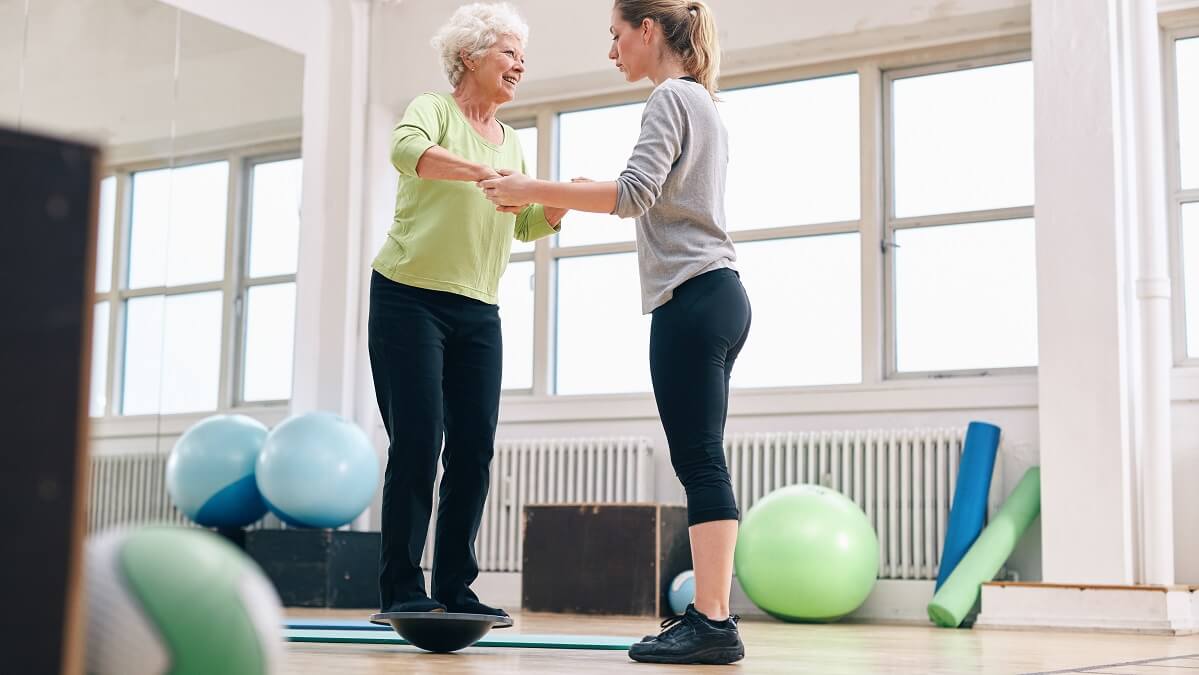There are plenty of things older people can do to stay active, healthy and independent – and among the best are balance exercises.
Regularly doing these exercises can help increase your body stability and strength, which in turn will help improve your mobility, endurance and overall quality of life. Balance exercises are suitable for all fitness levels and can be done without any equipment at home.
As you get older, it is normal for your balance to start deteriorating. This is because conditions such as arthritis, migraine, cardiovascular disease and visual impairment can affect your equilibrium. By regularly doing balance exercises you can counteract these effects.
How balance exercises particularly help older people
Balance exercises are important for people of all ages, but they are especially important for older people.
As we age, our bodies tend to lose muscle mass and bone density, which can lead to problems with balance. Balance exercises help to improve muscle strength and coordination, which can help to prevent falls.
They also help to improve balance and proprioception (the ability to sense where your body is in space), which can help to prevent injuries.
In a 2019 study, researchers found that balance exercises helped both younger and older adults to improve their:
- balance
- strength
- mobility
- reaction time
- quality of life.
Balance exercises may also be beneficial for people with certain health conditions that may impair balance, including:
- inner ear problems
- diabetes
- heart disease
- stroke
- vision problems
- thyroid issues.
How do balance exercises help?
Practising balance exercises can build strength and improve posture, coordination and stability, which all contribute to staying active for as long as possible.
One study found that older adults who did balance exercises for up to six weeks improved their balance control and confidence level. The exercises also enhanced their overall coordination, leg strength and ankle mobility.
Tips for a safe and effective workout
- Talk with a doctor before starting any new exercise routine.
- Before exercising, position a chair nearby to offer support and prevent falls.
- Stay hydrated and eat properly to reduce the possibility of light headedness or dizziness.
- Begin with simple exercises and slowly advance at a pace that feels comfortable.
- After exercising, cool down by stretching different muscle groups or taking long, deep breaths in and out.
Best balance exercises
There are many different types of balance exercises, and it is important to find ones that are appropriate for your fitness level and abilities.
Calf raises
- Stand with feet shoulder-width apart on a flat surface.
- Keep your back straight, shoulders back and down, and abs pulled in.
- Raise your heels slowly, keeping your knees extended (but not locked).
- Pause for one second when you’re standing as much on the tips of your toes as you can.
- Lower your heels back to the ground slowly and with control, returning to the starting position.
- Start with five repetitions and increase when you feel ready.
Small leg circles
- Stand with your feet hip-width apart, pressing your weight evenly and firmly into both feet.
- Place all your weight into the right foot and lift the left foot off the floor.
- Slowly draw a small circle with your left leg, first clockwise then anti-clockwise.
- Slowly lower your foot and repeat on the other side.
- Repeat five to 10 times
Tree pose
During this exercise, avoid placing the foot on the knee.
- Stand up straight next to a sturdy object for support.
- Shift your body weight onto your right foot.
- Place the heel of your left foot to the side or place the sole of your left foot against your right ankle, shin, or thigh.
- Place your hands together
- Hold for up to one minute.
- Repeat with your right foot.
Heel-toe walk
- Stand with feet together.
- Place your left foot directly in front of your right foot.
- Ensure the left heel touches the right toes.
- Place your right foot in front of your left foot.
- Ensure the right heel touches the left toes.
- Repeat 20 times.
Flamingo pose
- Stand up straight, close to a wall or chair.
- Shift the weight onto your right foot and lift your left foot off the floor, bending the knee to bring the left foot up high.
- Place your right hand on the wall or chair for support if needed.
- Hold your arms out to the side and draw small circles with them to increase the exercise difficulty level.
- Hold the pose for up to 15 seconds.
- Repeat with your other foot.
Normal ageing and various health conditions can impair your balance and make falls more likely. Balance exercises may help you stay physically active, increase your confidence, and reduce fall anxiety.
How often do you do balance exercises? Why not share your favourite one in the comments section below?
Also read: Could the ‘flamingo balance’ test be key to check-ups?

